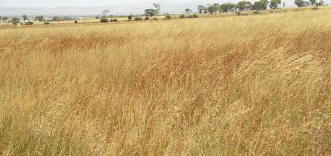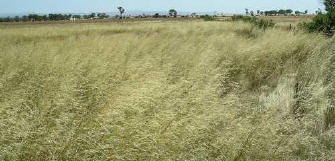|
Background |
 Photographs by Colin Rowan |
Mulla Mulla Grasslands (Bush's
Paddock) is a 45 hectare native grasslands site. It supports significant
remnants of Kangaroo Grassland and Greybox Grassy Woodland. |
Why Do We Bother! We see wide
open fields every time we go out into the country, vast fields of crops,
wheat, barley, canola etc, but as with pine plantations and the like these
are introduced, actual native grasslands are
 a
rare sight; less than 1% still remain. Could we cope if less than 1% of
forests were remaining? Native grasslands contain not just grasses, but
many other native plants as well. Plants such as Daises, Lilies, Orchids
abound. A healthy grassland prevents the invasion of the area by introduced
weeds. Bush's Paddock also contains a valuable stand of Grassy Woodland,
which apart from the grasses and plants provide a haven for wildlife and
also act as a wildlife corridor to adjoining forests. a
rare sight; less than 1% still remain. Could we cope if less than 1% of
forests were remaining? Native grasslands contain not just grasses, but
many other native plants as well. Plants such as Daises, Lilies, Orchids
abound. A healthy grassland prevents the invasion of the area by introduced
weeds. Bush's Paddock also contains a valuable stand of Grassy Woodland,
which apart from the grasses and plants provide a haven for wildlife and
also act as a wildlife corridor to adjoining forests.
Mulla Mulla Grasslands (Bush’s Paddock) is located in
the Shire of Melton on the western slope of Mt. Cotterell. It forms part of
the Victorian Volcanic Plains bioregion and contains the ecological
vegetation classes of plains grassland, plains grassy woodland. The average
rainfall is 450mm focusing on Mt. Cotterell ( height 204 meters).
Restoration planting has been undertaken using seeds from local provenance in the Mt. Cottrell/Exford region. Some of these have been propagated by members of the group. The planting of the threatened plant turkey-bush (eremophila deserti), propagated by a member of the group has been undertaken. Burning of dead boxthorn over winter, spot spraying serrated tussock during autumn and late winter/early spring are on-going maintenance jobs. In early spring it may be necessary to graze the annual grasses and broad-leafed weeds, and continue to spot spray phalaris aquatica. Further seed collection and propagation of understory species such as sticky everlasting (bracteantha viscosa) is a summer activity. Monitoring of emerging vegetation is undertaken using photography and mapping. Bird sightings are recorded and the Bird Observers Club Australia (BOCA) has undertaken to do quarterly surveys. Members of the group have monitored rabbits with spotlights, mapped and marked their holes and the rabbit proof fence is regularly checked. |
Pinkerton Landcare & Environment Group - Enter your slogan here

Mulla Mulla Grasslands
Latest News
- Wildflower Walk in Bush’s Paddock hosted by PLEG
- Rare Wide-faced Darner Dragonfly image taken by Citizen Scientist, Nora Peters.
- Another visit to MullaMulla Paddock
- PLEG protects volcanic plains woodlands and grasslands
- Community Day at Mulla Mulla Grassland
- Paddock Deep ... Mountain High
- Integrated control of serrated tussock on a native grassland, bush’s paddock. Or more than one way to kill a cat !
 These
basalt plains grasslands are of State significance and are important as
there remains less than 1% of native grasslands in Victoria today. Pinkerton
Landcare and Environment Group co-jointly manages Bush's Paddock along with
the Shire of Melton.
These
basalt plains grasslands are of State significance and are important as
there remains less than 1% of native grasslands in Victoria today. Pinkerton
Landcare and Environment Group co-jointly manages Bush's Paddock along with
the Shire of Melton.